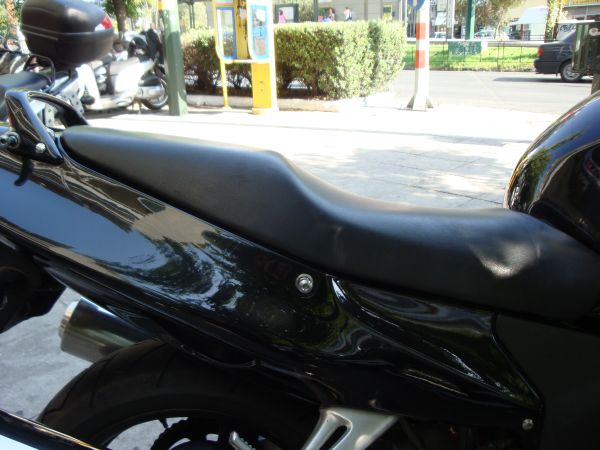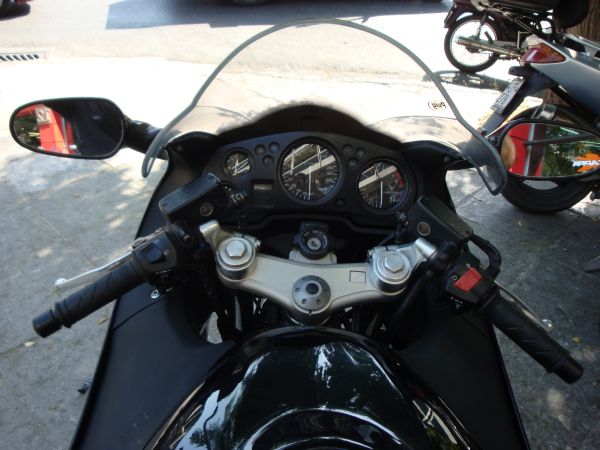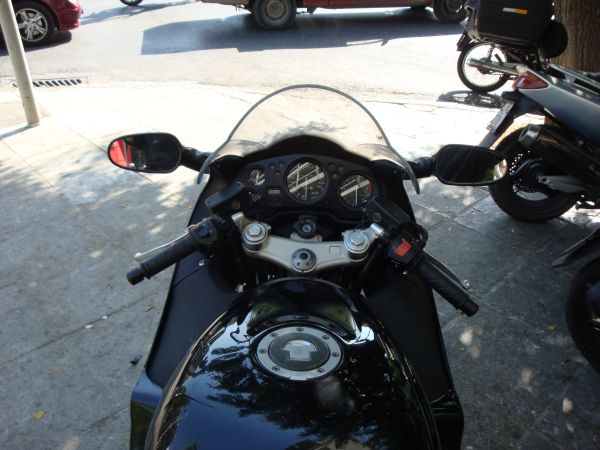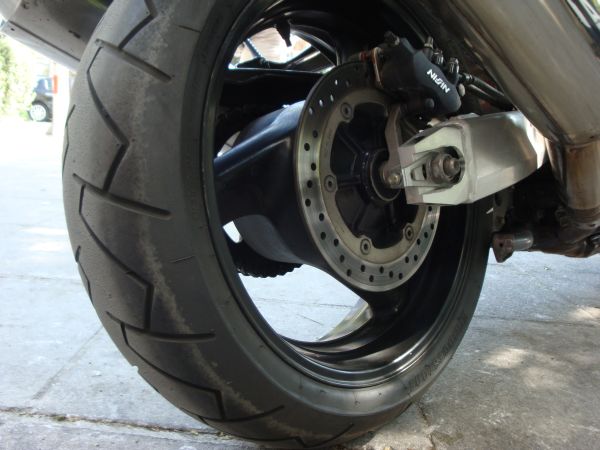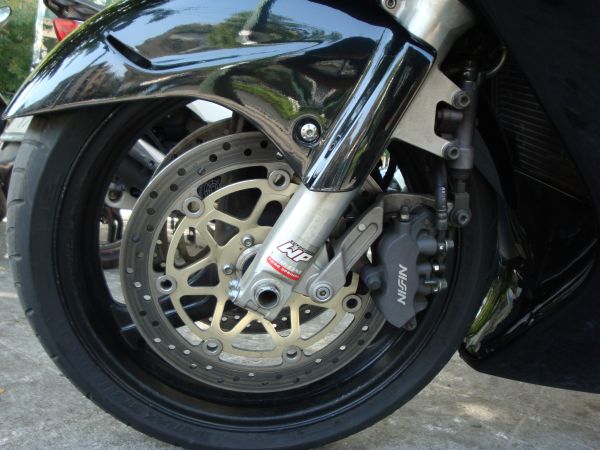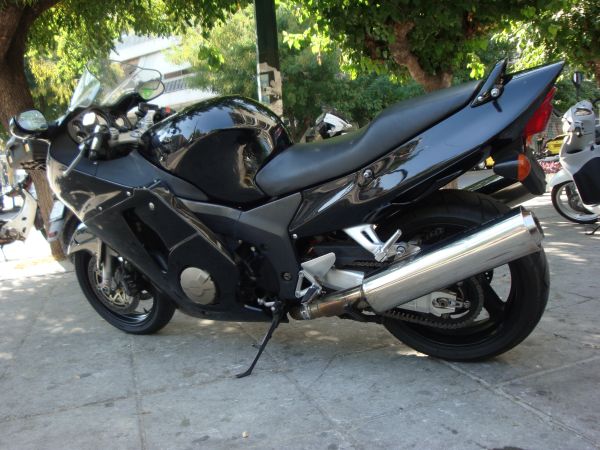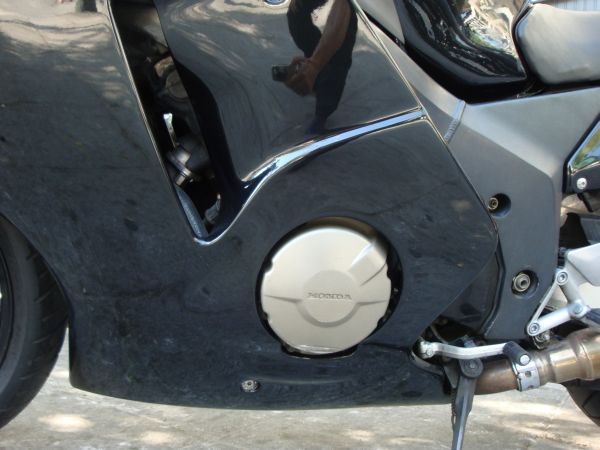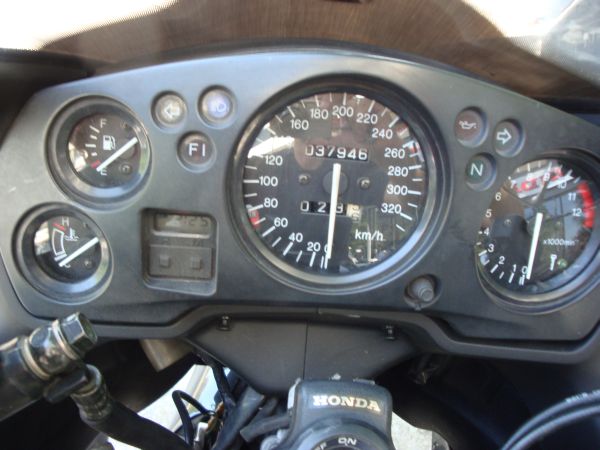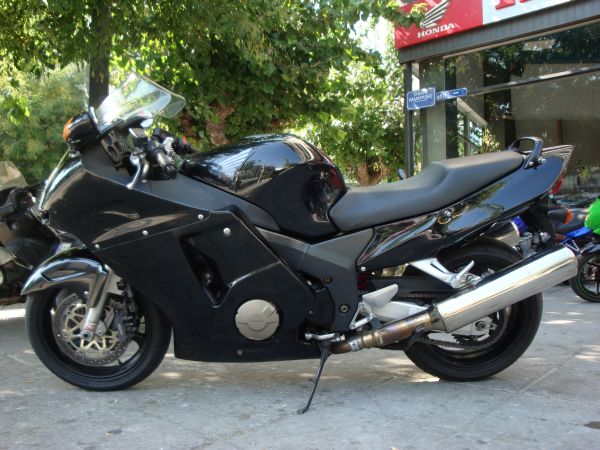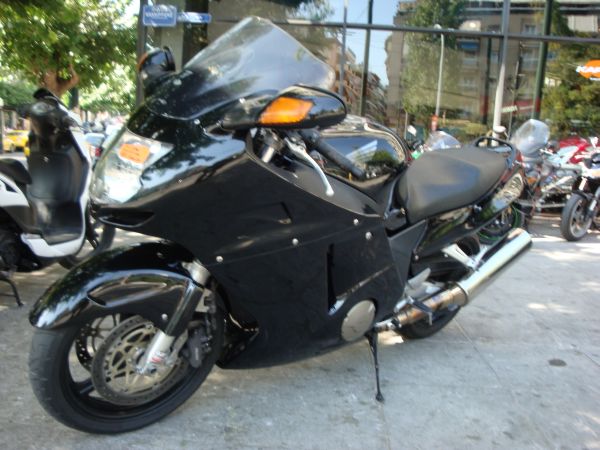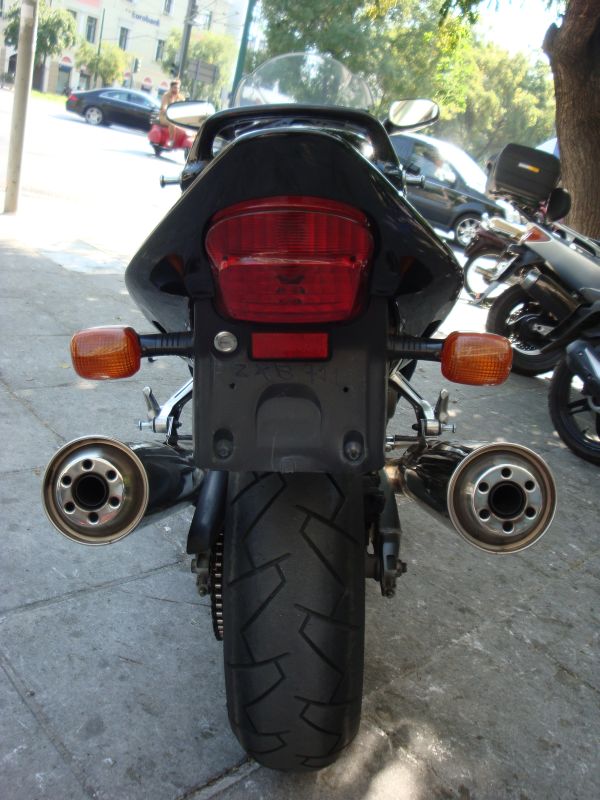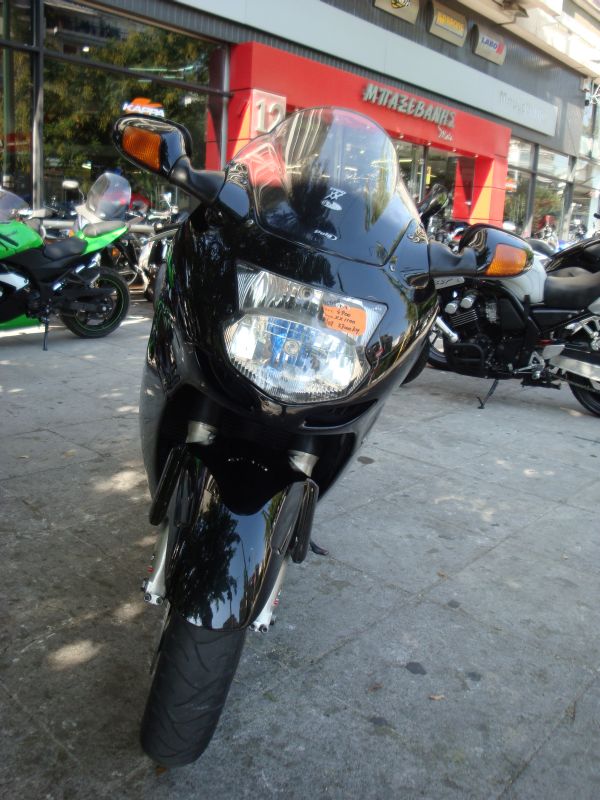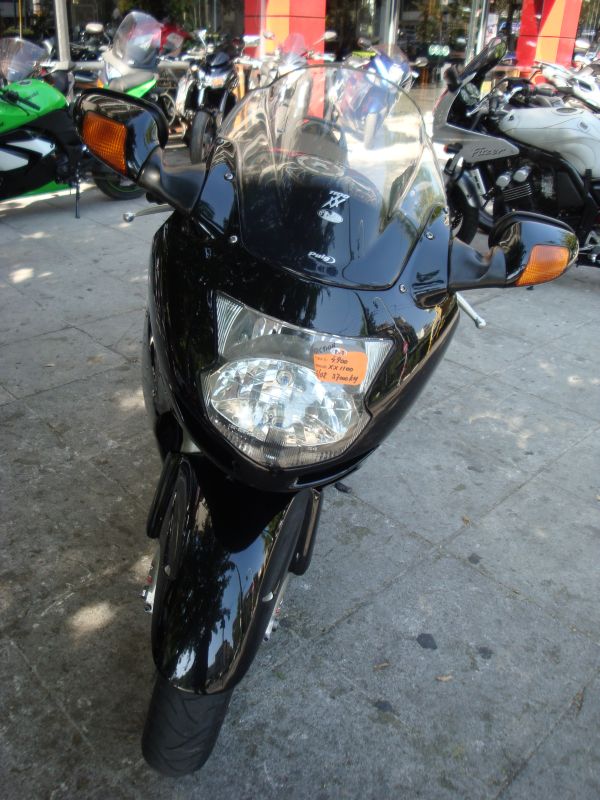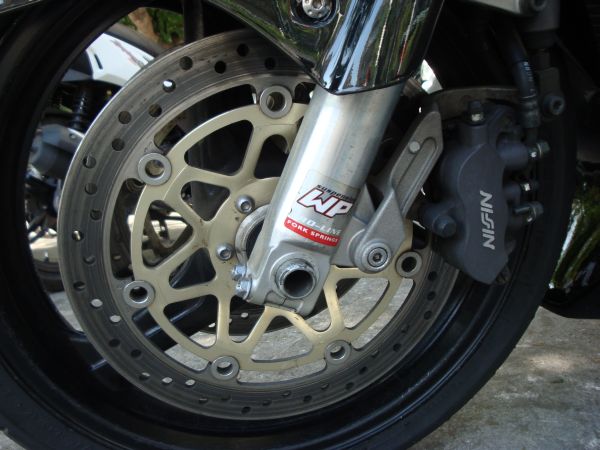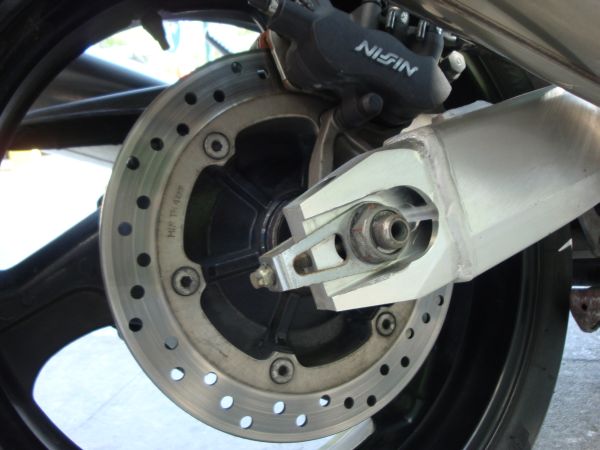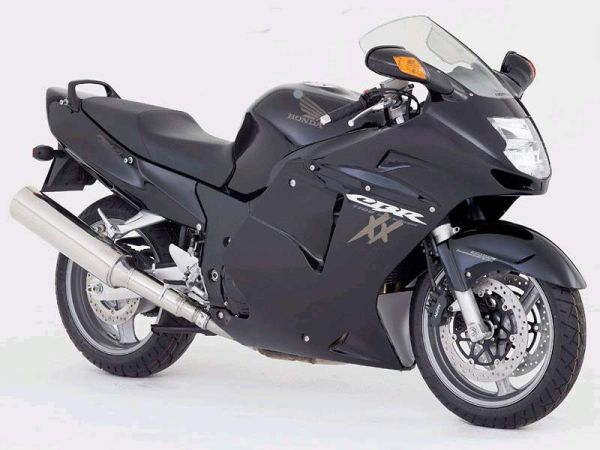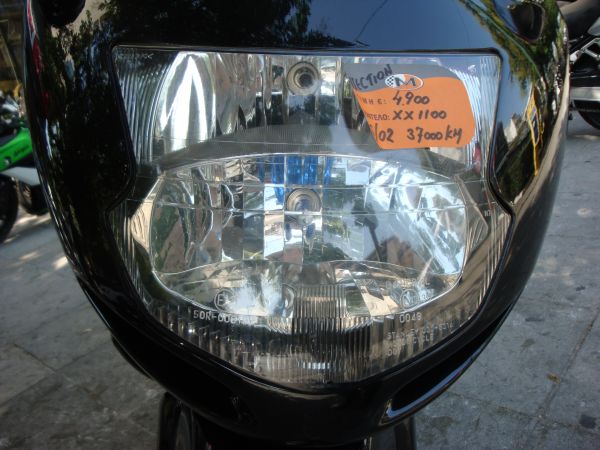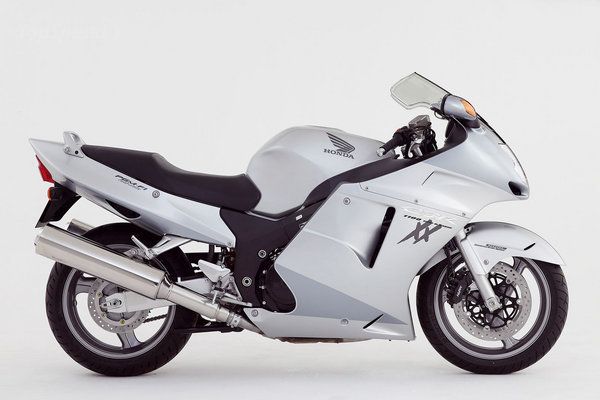Honda CBR1100 XX Super Blackbird -Used bike test- (1997 - 2008): Once upon a time, Honda invented a new bike category which was supposed to be just this fast.
The bike tested was a second hand 2000 model, with some 37000 km (23000 mi) on the clock. Engine: The four cylinder 1137 c.c. engine delivers 152 bhp/ 9500 rpm and 12.1 kgm / 7250 rpm (87.5 ft lbs/7250 rpm) torque, claimed figures.
Actually the thrust provided is punchy from the low end, while the top power is superb. The engine response is very linear, the gearbox is soft. An indicative fuel consumption figure is 7 l/100 km, (40.3 mpg Imperial).
Riding position: ‘he saddle height is average at 810 mm. Rider is placed in and over the bike. The riding position is leaning forward, placing the rider ideally for fast journeys, e.g. reminding of the HayabusaĘs riding position.
The pillion is seated much higher than the rider, the saddle is roomy, the saddle stiffness is normal, pillionĘs feet form a steep angle. Thus the pillion has to be supported either by the fuel tank or the rider.
Concerning the riding position, the length of the bike is large, forming an old fashioned sensation of a long bike. The width is increased only at the fairing area, just below the fuel tank. The height of the bike is normal. The weight of the bike is 253 kg (558 lbs) nominal curb, which is significant. If the bike is static and she leans marginally to either side the weight isnĘt felt much, if she leans more though or in case that rider has to push her, that weight figure cannot be hidden.
On the road: A 43 mm fork is equipped at the front which is not adjustable. The shock may be adjusted for spring preload and rebound damping. The suspensions are firm.
The tires fitted at the bike tested were Bridgestone BT-011 with dimensions 120/70-17 at the front and 180/55-17 at the rear. They are relatively good on high friction roads, if rider is willing to travel. On low-average friction factor roads or at the fast pace, they should be replaced with a softer compound.
In town the ◊◊ feels long and heavy. From the other hand she is a neutral and user-friendly Honda, which makes her a suitable bike for occasional urban use. If the fuel consumption was lower, rider would not really mind the compromises asked.
On downtown rides the Blackbird imposes compromises which are directly proportional to the traffic. Thus the steering lock is simply moderate. Filtering is average since the height of the bikeĘs mirrors is the same with that of car mirrors, the clip-ons are lower. Street imperfections are absorbed very well, indicating some suspension quality there. Due to the large engine, on downtown rides the heat dissipated from the engine may be felt low, on riderĘs legs.
On B-roads the ◊◊ boasts stability mostly. Again the long-heavy bike feeling is obvious and may be perceived as an old fashioned riding element. The torque and the engine linearity will be very helpful to the rider, either on normal rides or on a nimble pace. Even in this case, the XX is very satisfying, while with a smarter tire compound fitted, handling would be improved on low-friction factor roads.
At the fast pace the bike tested revealed some weakness, as feedback to the rider was decreased, which should be a result of tires and suspensions. However the calmness of the XX even at the fast pace is a great advantage, which could deceive an oblivious rider about the actual riding speed.
Its not that important if the body is hanging to the inside of the bend, the Blackbird is very stable and predictable especially on fast bends-sweepers.
On the highway the ◊◊ feels right at home (like John Rambo in the jungle! Here is a link if anyone wants to complain about this sort of humor!). The stability provided, the engine power and the air protection are really good, even by modern fast-touring standards. The bike is exceptionally comfortable between 170 and 200 km/h, (105-125 mph) there isnĘt any engine vibration either. This sort of speed is reached and preserved very easily. The travelling speed may be as high as 230 km/h (143 mph)..
With the aftermarket Puig screen fitted, the shoulders were the only area of the body not protected from the elements. Changing the standard screen is essential in the case of a tall rider. With a bike like this distances are covered swiftly, utterly easy and comfortably, even by todayĘs standards.
‘he brakes are combined and consist of twin 310 mm rotors at the front together with three pots calipers, while there is a 256 mm rotor at the rear, again with a three pots caliper. Applying the front brake activates the four pots at the edges of the front calipers, as well as the middle piston of the rear caliper. On the contrary, applying the rear brake only, the two middle pistons at the front calipers are actuated, together with the two pots at the ends of the rear caliper.
Braking is powerful, although feedback to the rider is moderate, while the initial bite is average. Of course the Balckbird always provided average braking feedback, although braking was always very effective. During the last years in production the bike could have been equipped with an ABS.
Model history/reliability/build quality/finish: The Blackbird was introduced in 1997 and that was the first and hopefully not the last time that Honda presented a motorbike capable of 300 km/h. Some minor modifications were performed in 1998 while in 1999 the engine got fuel injection and ram-air.
The latest improvements were introduced in 2001.
The XX was a motorbike which utilised conventional engineering design despite the high performance provided. Except only a few cases of faulty rectifiers, there were no reliability issues. The build quality and finish are superb, HondaĘs top class.
Comments: The mirrors are adjusted by the inside glass.
Maybe Honda felt slightly weird introducing the Blackbird, since she was one of the very few bikes presented at the line-up which was not compatible with HondaĘs politically correct approach.
Thus while at the beginning she was the fastest production bike ever, the first ever production motorcycle to reach 300 km/h (186 mph), extending the role of the Kawasaki ZZR 1100, the oncoming competition got mental: Kawasaki ZX12R, ∆∆R 1400, Suzuki Hayabusa 1300, even the Bmw K1300S nowadays. Honda was not willing to follow that …extreme path then.
Today (2013), the ◊◊ is still a remarkably fast bike which exceeds the limits of most riders. However the competition has got better, while the VFR1200F is more sport and less touring.
+ Still a very good and fast sport-touring motorcycle
+ Reliability-build quality
- Old-fashion riding-position sensation of a long bike
- Braking feedback





